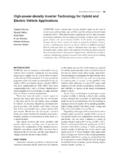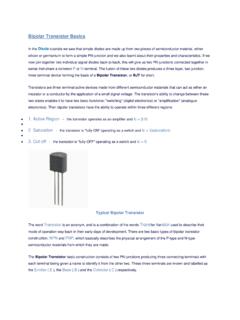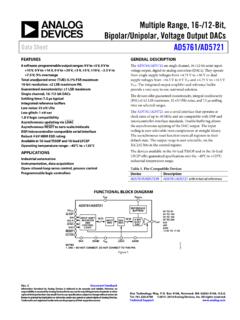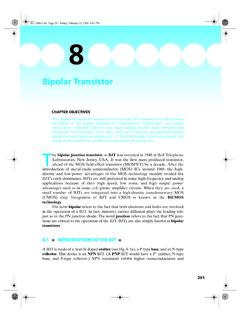Transcription of SAR ADC Input Types - Analog Devices
1 SAR ADC Input Types 5V 10V. IN SAR ADC IN SAR ADC. 0V 10V. GND GND. Figure 1a. Single-Ended Unipolar Figure 1b. Single-Ended True bipolar Single-Ended Inputs An ADC with single-ended inputs digitizes the Analog Input voltage relative to ground. Single-ended inputs simplify ADC driver requirements, reduce complexity and lower power dissipation in the signal chain. Single-ended inputs can either be unipolar or bipolar , where the Analog Input on a single-ended unipolar ADC swings only above GND (0V to VFS, where VFS is the full-scale Input voltage that is determined by a reference voltage) (Figure 1a) and the Analog Input on a single-ended bipolar ADC also called true bipolar , swings above or below GND ( VFS) (Figure 1b).
2 10V. 5V 5V. IN+ IN+ IN+. SAR ADC SAR ADC 10V SAR ADC. 0V 0V. IN IN IN . GND GND GND. Figure 2a. Pseudo-Differential Unipolar Figure 2b. Pseudo-Differential bipolar Figure 2c. Pseudo-Differential True bipolar Pseudo-Differential Inputs An ADC with pseudo-differential inputs digitizes the differential Analog Input voltage (IN+ IN ) over a limited range. The IN+ Input has the actual Analog Input signal, while the IN Input has a restricted range. A pseudo-differential unipolar ADC digitizes the differential Analog Input voltage (IN+ IN ) over a span of 0V to VFS.
3 In this range, a single-ended unipolar Input signal, driven on the IN+ pin, is measured with respect to the signal ground reference level, driven on the IN pin. The IN+ pin is allowed to swing from GND to VFS , while the IN pin is restricted to around GND 100mV (Figure 2a). A pseudo-differential bipolar ADC digitizes the differential Analog Input voltage (IN+ IN ) over a span of VFS /2. In this range, a single-ended bipolar Input signal, driven on the IN+ pin, is measured with respect to the signal mid-scale reference level, driven on the IN pin.
4 The IN+ pin is allowed to swing from GND to VFS, while the IN pin is restricted to around VFS /2 100mV (Figure 2b). A pseudo-differential true bipolar ADC digitizes the differential Analog Input voltage (IN+ IN ) over a span of VFS . In this range, a true bipolar Input signal, driven on the IN+ pin, is measured with respect to the signal ground reference level, driven on the IN pin. The IN+ pin is allowed to swing above or below GND to VFS , while the IN pin is restricted to around GND 100mV (Figure 2c). Pseudo-differential inputs help separate signal ground from the ADC ground, allowing small common-mode voltages to be cancelled.
5 They also allow single-ended Input signals that are referenced to ADC ground. Pseudo-differential ADCs are ideal for applications that require DC common-mode voltage rejection, for single-ended Input signals and for applications that do not want the complexity of differential drivers. Pseudo-differential inputs simplify the ADC driver requirement, reduce complexity and lower power dissipation in the signal chain. L, LT, LTC, LTM, Linear Technology and the Linear logo are registered trademarks of Linear Technology Corporation.
6 All other trademarks are the property of their respective owners. 5V. 10V. IN+ IN+. 0V. SAR ADC 10V SAR ADC. 5V. IN 10V IN . GND GND. 0V. 10V. Figure 3a. Fully Differential Figure 3b. Fully Differential True bipolar Fully Differential Inputs An ADC with fully-differential inputs digitizes the differential Analog Input voltage (IN+ IN ) over a span of VFS. In this range, the IN+ and IN pins should be driven 180 out-of-phase with respect to each other, centered on a fixed common mode voltage, for example, VREF /2 50mV. In most fully-differential ADCs, both the IN+ and IN pins are allowed to swing from GND to VFS.
7 (Figure 3a), while in fully-differential true bipolar ADCs, both the IN+ and IN pins are allowed to swing above or below GND to VFS. (Figure 3b). Fully-differential inputs offer wider dynamic range and better SNR performance over single-ended or pseudo-differential inputs. Fully differential ADCs are ideal for applications that require the highest performance. IN+, IN IN+, IN . ARBITRARY DIFFERENTIAL ARBITRARY DIFFERENTIAL. 5V 5V 5V 5V. 0V 0V 5V 5V. IN+ IN+. SAR ADC SAR ADC. bipolar UNIPOLAR bipolar UNIPOLAR . IN IN. 5V 5V GND 5V 5V GND.
8 0V 0V 5V 0V. Figure 4a. Differential with Wide Input Common Mode Figure 4b. Differential True bipolar Differential Inputs with Wide Input Common Mode An ADC with differential inputs digitizes the voltage difference between the IN+ and IN pins while supporting a wide common mode Input range. The Analog Input signals on IN+ and IN can have an arbitrary relationship to each other. In most differential ADCs, both IN+ and IN remain between GND and VFS (Figure 4a), while in differential true bipolar ADCs, both the IN+ and IN.
9 Pins are allowed to swing above or below GND to VFS (Figure 4b). Differential inputs are ideal for applications that require a wide dynamic range with high common mode rejection. Being one of the most flexible ADC Input Types , an ADC with differential inputs can also digitize other Types of Analog Input signals such as single-ended unipolar, pseudo-differential unipolar/ bipolar and fully-differential. Input Types Linear Technology SAR ADCs Single-Ended Unipolar LTC1865, LTC2314, LTC2315, LTC2360, LTC2361, LTC2362, LTC2365, LTC2366.
10 Single-Ended Single-Ended True bipolar LTC1400, LTC1404, LTC1605, LTC1606, LTC1609. Pseudo-Differential Unipolar LTC1864, LTC2305, LTC2306, LTC2308, LTC2309, LTC2364, LTC2367, LTC2368, LTC2369, LTC2370, LTC2389, LTC2372, LTC2373. Pseudo-Differential Pseudo-Differential bipolar LTC2305, LTC2306, LTC2308, LTC2309, LTC2389, LTC2372, LTC2373. Pseudo-Differential True bipolar LTC1414, LTC1419, LTC1854, LTC1855, LTC1856, LTC1857, LTC1858, LTC1859, LTC2328, LTC2327, LTC2326. Fully Differential LTC2376, LTC2377, LTC2378, LTC2379, LTC2380, LTC2383, LTC2389, LTC2393, LTC2372, Fully Differential LTC2373.

















